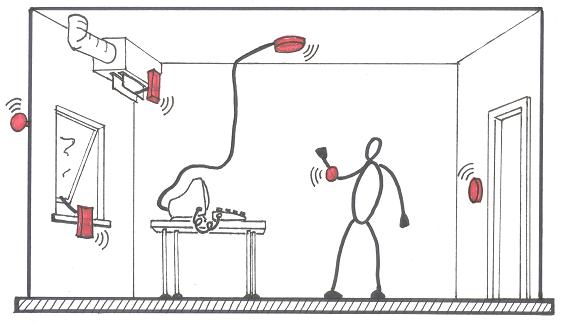Personalized Building Comfort Control

System Components: wrist sensors, HVAC damper actuators, window actuators, outdoor sensors, room sensors, and coordinator nodes
Creating an appropriate indoor climate is essential to worker productivity and personal happiness. It is also an area of large expenditure for building owners. And, with rising fuel costs, finding ways of reducing energy consumption is more important than ever. This idea is promoted further by the notion that most buildings are currently being run inefficiently, due to the non-adaptable nature of their control systems. Not just the occupants, but also the buildings themselves have ever changing needs, for which a single setpoint is inadequate. This dissertation presents a novel air-conditioning control system, focused around the individual, which remedies these inefficiencies through the creation of personalized environments.
To date, the measurement of thermal preference has been limited to either a complex set of sensors attempting to determine a Predicted Mean Vote (PMV) value, or to direct polling of the user. The former is far too cumbersome and expensive for practical application, and the latter places an undue burden on the user. To overcome these limitations, an extremely low power, light weight, wireless sensor is developed which can measure temperature, humidity, activity and light level directly on the user's body. These data are used to immediately infer user comfort level, and to control an HVAC system in an attempt to minimize both cost and thermal discomfort.
Experimental results are presented from a building under continual usage, modified with a wireless network with multiple sensing and actuating modalities. For four weeks, ten building occupants, in four offices and one common space, are thermally regulated via wrist-worn sensors controlling the local air-conditioning dampers and window operator motors. Comparisons are made to the previous four week period of standard air-conditioning control, showing an increase in comfort, while decreasing energy usage at the same time. The difficult problems of control adaptation, comfort determination, and user conict resolution are addressed. Finally, the limitations of this format of control are discussed, along with the possible benefits and requirements of this proactive architecture.
Video clip showing the system in action:
HVAC Video (78 meg): A tour of the components and functionality of the system.
Relevant Papers and Reports:
A short paper on this system presented at IoT 2010 :
Personalized HVAC Control System, Feldmeier, M., and Paradiso, J.A., in the Proc. of Internet of Things (IoT) 2010, Tokyo Japan, Nov. 29 - Dec. 1, 2010.
Mark Feldmeier's Media Lab Phd Thesis:
Mark C. Feldmeier -- Personalized Building Comfort Control (pdf) September 2009.
Acknowledgements:
This work was partially funded by an anonymous donor through the MITEI, and through a fellowship from the Martin Family Society of Fellows for Sustainability.


